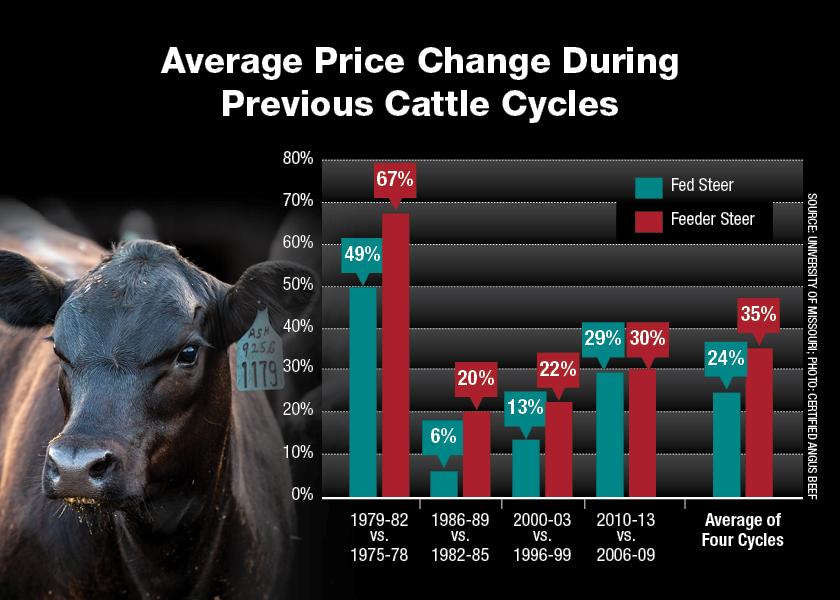How Previous Cattle Cycles May Predict Coming Market Trends

Cattle and beef market forecasts remain as positive at mid-summer as economists had projected at the beginning of the year. In fact, feeder cattle and calf markets have exceeded many expectations which is good news for ranchers.
Unfortunately, the expanding drought has forced an unprecedented culling of beef cows throughout most of America’s large cow-calf producing states. The U.S. Drought Monitor the first week of July reported 70% of the contiguous U.S. was experiencing moderate to severe drought conditions.
That level of drought is driving beef cows to market in historic numbers. Through the end of June, total cow slaughter was 6.1% higher than during the same period of last year even as dairy cow slaughter decreased by 3.1%. The total spiked higher due to beef cow slaughter that was 14.6% higher than in 2021.
“Consistently high beef cow slaughter levels for the first half of 2022 ensure that the January 2023 U.S. beef cow inventory will decline for the fourth consecutive year,” says University of Missouri livestock economist Scott Brown.
Economists believe the rapid beef cow liquidation that has already occurred in 2022 may put the industry on track to reduce the nation’s cowherd back near 2014 levels, which – at 29.0 million head – was the smallest beef cowherd since 1952.
USDA’s annual cattle inventory report found 30.13 million beef cows on Jan. 1, 2022, a decline of 2.3% from the previous year. Already the numbers suggest the beef cow inventory will contract, possibly by another 1 million, leaving next January’s total about equal to that of 2014.
“We saw a 9% increase in beef cow slaughter last year, and a net herd culling of 11.6%,” says Derrell Peel, Oklahoma State University livestock economist. “Drought expanded and accelerated herd liquidation in 2021, leading to a 2.33% decrease in the beef cow herd.”
Beef cow culling during the first half of 2022 guarantees an overall decline for the year.
“Just holding cow slaughter for the remainder of the year equal to last year would result in an annual increase in cow slaughter of 5.9%,” which Peel said was unlikely due to the expanding drought. He suggests the current level of cow culling would result in a culling rate in excess of 13% for 2022 and a potential beef cow herd decline of one million head or more.
How might that decline in beef cows affect your prices for feeder cattle and fed steers? At Missouri, Brown examined the price behavior of similar points in the cattle inventory cycle going back to the mid-1970s. Since then, there have been four other instances in which beef cow inventory numbers declined for four or more consecutive years: 1976-79; 1983-86; 1997-2004 and 2007-2014.
“In every case during the previous four cattle cycles, both national indicator fed steer prices and 600 to 650-pound Oklahoma City feeder steer prices posted higher average levels in the four years following the position in the cycle that we will see at the beginning of 2023,” Brown said. “That average price increase in these cycles was 24.4% for fed steers and 34.7% for feeder steers.”
Taking the smallest and largest percentage changes over the previous four cycles yields a range of $129.14 to $181.95 for fed steers and $188.72 to $264.14 for feeders.
Retaining ownership
Late summer offers an opportunity to review your calf marketing plan and make necessary adjustments. Often, retaining ownership of your calves through a background phase or through the finishing phase offers the potential for additional revenue. This is unlikely to be one of those years.
“The risk/reward is not in a rancher’s favor for retaining ownership this year,” says Sterling Marketing president John Nalivka. “Yes, fed cattle prices are higher and they look to gain even more in the months ahead. But the cost of feeding cattle is significantly higher.”
Sterling Marketing estimates that feed costs for cattle placed the first week of July were 28% higher than the previous year and totaled $570 per head. For cattle placed on feed in October, Sterling projects the total feed cost at roughly $540 per head with the cattle marketed in March of 2023.
The greatest risk to retained ownership, however, is the price of feeder cattle. Sterling projects 750 to 800-pound feeder steers will sell in October for $171 per cwt., or $1,325 per head. That’s roughly $150 per head more than those same feeder steers sold for in October 2021.
“The cost of feeder cattle is the primary diver of breakeven prices for feedlots and represent 60% to 70% of the cost to the feedlot,” Nalivka says. “The total costs for feeding a steer is going to be 15% to 20% higher this year, which means the breakeven will be that much higher. That will make it difficult to increase any profits a rancher already has in his calves or feeder cattle.”







